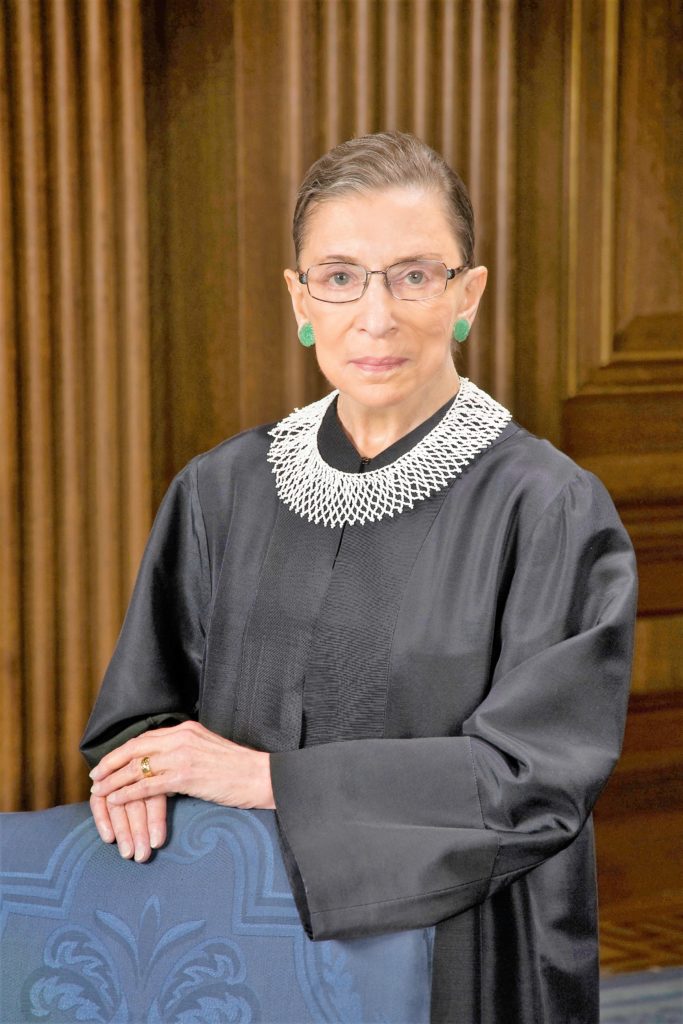Ruth Bader Ginsburg’s Road to the Highest Court
By LIBBY MOTIKA
Contributor to Circling the News
RBG, the meme of the moment. Hard to tell whether it’s Ruth Bader Ginsburg’s biography, her phenomenal rise to the pinnacle of American Jurisprudence or the energized fight for equal justice and liberty in this country for all people, that explains her rock-star status.
Riffing on the rap artist Biggie Smalls, aka Notorious BIG, the Skirball Cultural Center is celebrating Ginsburg in a fun way, cheeky, yes, but substantive. The exhibition “Notorious RBG: The Life and Times of Ruth Bader Ginsburg” is on view through March 10.
The Justice herself, a distinguished scholar and serious reader of the Constitution, has accepted the sly acronym “Notorious RBG,” suggesting that she and the rapper have a lot in common. “We’re both from New York City,” she has said.
“She uses all of this Notorious RBG stuff, particularly where young people are concerned, to convey her views about issues that she thinks are important,” said Jane Sherron De Hart, author of “Ruth Bader Ginsburg: A Life,” in the Santa Barbara Independent.

Official portrait of United States Supreme Court Justice Ruth Joan Bader Ginsburg. Courtesy of WDC photos/Alamy Stock Photo.
The Skirball’s exploration of RBG’s rich biography underscores the “amazingness” of the woman. This is the justice who has never missed a day on the bench, despite being a two-time cancer survivor. The same woman who has a profound understanding of the Constitution is also the woman who can do 20 pushups every morning.
Curated by Irin Carmon and Shana Knizhnik, co-authors of the book of the same name, the exhibition could probably be subtitled, the “spirit of perseverance,” cogently exemplified Ginsburg’s dissent in the voting rights case in 2013. In that case, one of her five dissents in that session, she extended Martin Luther King, Jr.’s belief that the “arc of history bends toward justice,” by adding “if there is a steadfast commitment to see the task toward completion.”
Before the exhibition explores the specifics of certain key cases, the viewer is offered a simple schematic on the history of the judicial branch and how it works.
The curators and Skirball preparators have worked hard to present Ginsburg’s life, tying her early experiences and accumulated life and career challenges to contemporary themes.
From her childhood in Brooklyn, Ginsburg learned the importance of her Jewish values and academic achievement. To this day, RBG regards her mother Celia, daughter of immigrants who fled the Austro-Hungarian Empire, the most important person in her life, who instilled the discipline of study and asking questions.
In the context of today, it is hard to imagine the circumstances for a woman in the 1950s. RBG enrolled at Cornell in 1950, an institution where there were four men to every woman, and where she saw racial injustice threats to civil rights carried out in the McCarthy hearings.
A serious quiet young woman, Ruth met her future husband Marty Ginsburg at Cornell; a man she remembers “as ever so much smarter than my boyfriend at Columbia Law School.” Marty was by all accounts the gregarious “life of the party.” Also a successful lawyer and law professor, he supported Ruth in her career, even taking over the cooking. A keen cookbook enthusiast, he gladly relieved a reluctant Ruth from kitchen duties completely in 1980. The division of labor in the family, daughter Jane would say, developed into this: “Mommy does the thinking and Daddy does the cooking.”

Ruth Bader Ginsburg ’59 is appointed the first female member of the Columbia Law School faculty in 1972. She had taught previously at Columbia in International Civil Procedure with Prof. Hans Smit’58 in 1961. She is the first female candidate to earn tenure at Columbia Law School.
Their marriage turned out to be a beautiful, compatible and loving relationship until Marty’s death in 2010.
Certain key moments in RBG’s career as a lawyer and advocate for justice and equality laid the foundation for her continued focus on equal rights, women’s equality and the end of sex discrimination under the law.
In one of her earliest briefs (Reed v. Reed), Ginsburg used the 14th Amendment’s equal protection clause to defend the rights of a wife in the disbursement of material possessions after the death of her son. Her husband, from whom she was divorced, was considered the only legitimate heir.
In her brief, Ginsburg included the names of two ACLU lawyers, who had argued as far back as 1961 that the equal protection clause might on its own free women of legal constraints. Bucking tradition, Ginsburg nevertheless added the names of the two pioneer civil rights lawyers, saying her work was carrying on what Dorothy Kenyon and Pauli Murray had pioneered.
Perhaps one of the most unexpected events in Ginsburg’s career was her nomination to the Federal bench. Before Jimmy Carter took office in 1977, there was only one woman serving on the Federal bench, Shirley Hofstetter. He promised that he would appoint women to substantive positions, and RBG was one of those women.
This was never a thought in RGB’s life expectations. She credits the President, but also a strong network of women advocates and the birth of the Women’s Movement. Once again, she reiterated the importance of remembering that nobody does anything alone, and it was the support from her colleagues that resulted in her lifetime appointment.
The appointment to the Supreme Court, as we’ve learned in the last few decades, courses along a sinuous path before reaching confirmation. In considering RGB in 1993, President Clinton was worried there would be resistance from women’s groups, because Ginsburg had critiqued Roe v. Wade, not because she didn’t agree with the outcome but she thought the court should have gotten there in a different way, basing it on autonomy not on privacy issues.
Clinton later said that a lot of people had people advocating for them, but it was really after the personal interview with Ginsburg that made his mind up.
After a quarter century on the Supreme Court, Ginsburg continues to focus on her core beliefs. In a time of tremendous backlash, RBG says she loves her job, and “I have more confidence in my judgment than ever.”



Awesome exhibit I went on Nov 2nd evening something special at Skirball. I encourage all women to see this exhibit. Thank You for your article on CTN.